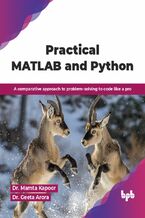Ultimate Data Science Programming in Python Saurabh Chandrakar
- Autor:
- Saurabh Chandrakar
- Wydawnictwo:
- BPB Publications
- Ocena:
- Stron:
- 556
- Dostępne formaty:
-
ePubMobi
Opis
książki
:
Ultimate Data Science Programming in Python
In today's data-driven world, the ability to extract meaningful insights from vast datasets is crucial for success in various fields. This ultimate book for mastering open-source libraries of data science in Python equips you with the essential tools and techniques to navigate the ever-evolving field of data analysis and visualization.
Discover how to use Python libraries like NumPy, Pandas, and Matplotlib for data manipulation, analysis, and visualization. This book also covers scientific computing with SciPy and integrates ChatGPT to boost your data science workflow. Designed for data scientists, analysts, and beginners, it offers a practical, hands-on approach to mastering data science fundamentals. With real-world applications and exercises, you will turn raw data into actionable insights, gaining a competitive edge. This book covers everything you need, including open-source libraries, Visual Explorer tools, and ChatGPT, making it a one-stop resource for Python-based data science.
Readers will gain confidence after going through this book and we assure you that all the minute details have been taken into consideration while delivering the content. After reading, learning, and practicing from this book, we are sure that all IT professionals, novices, or job seekers will be able to work on data science projects thus proving their mettle. Key Features
Master key Python libraries like NumPy, Pandas, and Seaborn for effective data analysis and visualization.
Understand complex data science concepts through simple explanations and practical examples.
Get hands-on experience with 300+ solved examples to solidify your Python data science skills. What you will learn
Learn to work with popular IDEs like VS Code and Jupyter Notebook for efficient Python development.
Master open-source libraries such as NumPy, SciPy, Matplotlib, and Pandas through advanced, real-world examples.
Utilize automated EDA tools like PyGWalker and AutoViz to simplify complex data analysis.
Create sophisticated visualizations like heatmaps, FacetGrid, and box plots using Matplotlib and Seaborn.
Efficiently handle missing data, outliers, and perform filtering, sorting, grouping, and aggregation using Pandas and Polars. Who this book is for
This book is ideal for diploma, undergraduate, and postgraduate students from engineering and science fields to programming and software professionals. It is also perfect for data science, ML, and AI engineers looking to expand their expertise in cutting-edge technologies. Table of Contents
1. Environmental Setup for Using Data Science Libraries in Python
2. Exploring Numpy Library for Data Science in Python
3. Exploring Array Manipulations in Numpy
4. Exploring Scipy Library for Data Science in Python
5. Line Plot exploration with Matplotlib Library
6. Charting Data With Various Visuals Using Matplotlib
7. Exploring Pandas Series for Data Science in Python
8. Exploring Pandas Dataframe for Data Science in Python
9. Advanced Dataframe Filtering Techniques
10. Exploring Polars Library for Data Science in Python
11. Exploring Expressions in Polars
12. Exploring Seaborn Library for Data Science in Python
13. Crafting Seaborn Plots: KDE, Line, Violin and Facets
14. Integrating Data Science Libraries with ChatGPT Prompts
15. Exploring Automated EDA Libraries for Machine Learning
16. Case Study Using Python Data Science Libraries
Wybrane bestsellery
Saurabh Chandrakar - pozostałe książki
BPB Publications - inne książki
Dzięki opcji "Druk na żądanie" do sprzedaży wracają tytuły Grupy Helion, które cieszyły sie dużym zainteresowaniem, a których nakład został wyprzedany.
Dla naszych Czytelników wydrukowaliśmy dodatkową pulę egzemplarzy w technice druku cyfrowego.
Co powinieneś wiedzieć o usłudze "Druk na żądanie":
- usługa obejmuje tylko widoczną poniżej listę tytułów, którą na bieżąco aktualizujemy;
- cena książki może być wyższa od początkowej ceny detalicznej, co jest spowodowane kosztami druku cyfrowego (wyższymi niż koszty tradycyjnego druku offsetowego). Obowiązująca cena jest zawsze podawana na stronie WWW książki;
- zawartość książki wraz z dodatkami (płyta CD, DVD) odpowiada jej pierwotnemu wydaniu i jest w pełni komplementarna;
- usługa nie obejmuje książek w kolorze.
Masz pytanie o konkretny tytuł? Napisz do nas: sklep@ebookpoint.pl
Książka drukowana


































Oceny i opinie klientów: Ultimate Data Science Programming in Python Saurabh Chandrakar
(0)